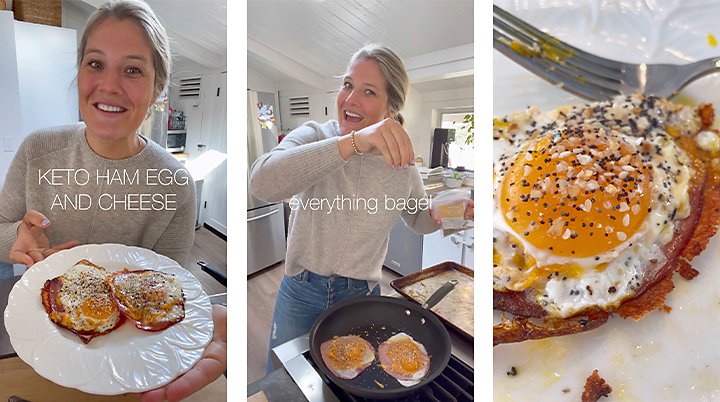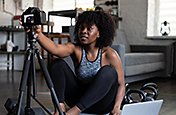Cook up sizzling food videos
From your favorite ice cream taco recipe to short films about flying waffles, learn how to create food videos that entertain and entice.
Video by David Ma
Focus on the food.
Food videos tend to fall into two main categories: recipes and promo videos. A good food recipe video shows you how to make certain dishes. NYT Cooking and Buzzfeed’s Tasty YouTube channels both feature these types of “hands and pans” videos.
The food commercial or promotional spot is all about showing off the product, enticing the viewer, and inspiring them to go out and get it. (Picture the fast food commercial staple of a steaming, golden french fry lovingly dusted with salt.) As long as these videos sell the product, they can get wildly creative.
Whether they’re recipe videos from the Food Network, inspirational dessert videos from So Yummy, mouthwatering commercials, or just satisfying food video compilations, food-centered content is popular around the world. According to Engadget, food videos generate twice as many interactions on Facebook as fashion videos, the second most popular category. Social media analytics blog Fanpage Karma found that on Instagram, food videos are second only to fashion.
Teach people how to make delicious food.
Recipe videos used to be long and detailed, but in the age of TikTok and Instagram Reels, short-form recipe content has become standard. To give your video the best chance of picking up views and likes, start with a specific idea. Focus on a single dish, appliance, or kitchen hack that you want to feature. Then, rehearse.
Do a few test runs.
It’s important to try out your recipes before you make them on camera. That way, you know you’ve included everything a viewer needs, and you know it will taste good. “Nothing ruins your credibility faster than people trying to cook your recipe and having something not work or finding out an ingredient is missing,” says chef Caroline Chambers. “Make sure that every single recipe you publish is really well tested and written as simply and clearly as possible.”
Light it.
The allure of food in a video depends on vivid colors, so good lighting is crucial. “If your kitchen isn’t naturally lit, make sure that you have proper lighting to make everything pop,” says Chambers. “I use several ring lights to bounce light around the kitchen.”
Shoot it.
Chambers, who posts her videos on Instagram Reels, shoots on her iPhone. She says recording adds 20 to 30 minutes to her cooking time. “The more shareable videos don’t focus too much on the details,” Chambers says. “They give a brief overview, and people can read the actual recipe in the caption if they need more details.
“Don’t let the desire to get a perfect video up stop you from just getting a video up,” she says. “It feels a little embarrassing when you start putting yourself out there, but there’s no time like the present. Just get your first video up there. It does not have to be perfect.”
Edit for personality.
If you’re new to video editing, be patient and know that you’ll get better with each video. Also, the practice of editing will help you develop your style. “I started with ‘hands and pans’ style videos, and they just aren’t as engaging,” Chambers says. “I found that inserting a bit of my personality, actually being in them, is what has made my videos start to click.”

Images by Caroline Chambers
Think about what makes you and your cooking unique, and try to highlight that in your edit. If you’re the kind of foodie who lives to bake chocolate cakes, brownies, and cupcakes, don’t cut out moments of joyful tasting or soliloquies on the beauty of a single chocolate chip.
Pick the right cover photo.
On social media, the cover image often determines whether or not people click on a cooking video. “Find a really beautiful still image of the recipe or whatever you’re trying to demonstrate,” Chambers says. “Use natural lighting and make sure the plate looks really clean. Go simple and approachable with your styling, and focus on the food because it’s a really small image.”
Add text overlays and captions.
Captions are crucial, Chambers says. “So many people watch videos on mute because they’re at work or they’re with their kids, so I caption everything. It takes a long time, but the engagement is so much higher because the people who are watching on mute can actually understand what’s going on.”
It’s easy to add titles and captions in Adobe Premiere Pro. Once you have a final cut of your video, add a Caption Track to your timeline, choose the format and style, and add it manually. You can edit captions as you would any other video track.
Incorporate feedback and strategize.
Use constructive comments from viewers to find your niche. “If people say, ‘Oh, I love that trick you did,’ focus on that trick,” Chambers says. “If they say they loved how your kids were in it at the end tasting the food, great. Throw your kids in there.”
Chambers also advises paying attention to what each platform is optimizing for. If it’s short, quick videos, as on TikTok or Instagram Reels, make those. “Don’t get frustrated,” she says. “Just figure it out and do it. Take a webinar, read articles, and figure out how to make content that’s really great.”
Don’t spend too much time comparing your content to others’. You don’t need a big budget and a whole production team behind you to succeed. “You just need your personality and your niche in the food world,” Chamber says. “My videos are by no means perfect. My lighting is off and my baby’s screaming in the background and that’s okay, because it shows who I am.”
Videos by David Ma
Make awesome food commercials.
Unlike recipe videos, food ads are purely about entertainment and enticement. Even if you’re trying to sell foods that don’t naturally pop on-screen, like frozen cheesecake or instant mashed potatoes, find a way to make them memorable.
Director David Ma uses fantasy and whimsy — and high-speed cameras, robots, and the occasional explosive — in his food videos. Ma began making fantastic short food films that led to work making commercials in the same style. “When clients come to me, they’re not just looking to show off a plate of food. They’re looking to build a world around that food. We’re not just shooting spaghetti and meatballs, we’re creating a Tarantino world of spaghetti and meatballs,” Ma says.
Whether you just want to make something to build your video portfolio or you’ve been hired to shoot a commercial, the general steps are the same.
Get a crew together.
At first, you might need to ask friends for help. “Even if it’s just a friend who knows nothing about film, who can help you literally just wipe countertops or prepare 18 chicken breasts, it’s one less thing for you to think about,” Ma says.
As you get further along in your career, your crew will get bigger. “One person cannot do all the jobs on a polished food shoot,” Ma says. “You’ve got to have a culinary producer, a food stylist, a hand model, gaffers and grips who light the scene, prop stylists, and production designers who build these intricate sets.”
Write the script and create storyboards.
Once you know what the project is, it’s time to write it up. Keep the script simple and focused, since you have only seconds to get people’s attention. Even if a client hands you a script, flesh it out so you understand camera angles and timing. “Storyboards are crucial, not just for the clients to understand what we’re about to shoot, but for the crew to understand how we’re going to bring it to life,” Ma says.
You should also write a treatment, explaining how you see the lighting and cinematography working, describing the tone of the voice-over or the action and personality of the hand model. “A treatment is necessary for the process of winning commercial clients. You have to demonstrate what your vision is in a very tangible way,” Ma says.
But remember that your most important task is to sell the product, so don’t let your artistic aspirations get in the way of that. “You’re there for the clients,” Ma says. “Your job is to make this food look stunning and spectacular.”
Video by David Ma
Test and repeat.
For a carefully orchestrated food video production, rehearsal is crucial. Along with high-speed cameras capable of super slow motion, Ma’s team uses a robot to ensure that even the simple action of flipping a burger is perfect. “We've automated it so we know the burger goes exactly nine and a half inches up towards the camera, because that’s where our focus point is,” Ma says. “But it wasn’t always like that. Before, I was the one flipping the burger 1100 times to get the perfect shot.”
Don’t be afraid to invent DIY solutions and see how they work. “As somebody who never went to film school, I relied a lot on just tinkering, seeing what other creators have done, and putting my own spin on that,” Ma says.
When you start a shoot, be prepared to try several takes. “Don’t think that the first take is going to be the one,” Ma says. “Even as a professional, I shoot french fries falling and getting tossed with salt 23 times to get the right one.”
If there are hands in the shot, pay close attention to how the hands act. “There’s a lot of personality and nuance that can come through in the way you spread a peanut butter sandwich,” Ma says.
Video by David Ma
Make it ’til you make it.
Persistence is crucial, not just for getting a shot right, but for pursuing a career as a food videographer. “The only way to get better at something is to continually make it,” Ma says. Study the work that inspires you and try to replicate it. Try to reverse-engineer commercials you like to figure out for yourself how they were made. Do some internet research to see how they did it. (Ma’s TikTok page is full of behind-the-scenes footage.)
Also try to learn as much as you can from others. “PA on as many food shoots as you can,” Ma says. “Even if you’re not getting paid for it, be there for eight hours and listen to the food stylists. Watch how the director directs talent. Take notes on how they do the lighting, so you can understand how to create cool silhouettes or cinematic effects.”
Develop your video and audio editing skills with Premiere Pro. Explore tutorials on everything from adjusting the timing of your edits to doing color correction. Through courses for beginners and experienced editors, you can even learn how to add animated title sequences and mix multiple audio tracks.
Finally, don’t wait to get hired. Whether you want to show people how to whip up your favorite chicken recipe or you want to create a commercial for your favorite fast food restaurant, just make the videos you want to make — in your own style. If you keep trying, learning, and improving, eventually your videos will gain traction, or people will hire you to apply your style to their commercial.
Contributors
Do more with Adobe Premiere Pro.
Make visually stunning videos virtually anywhere — for film, TV, and web.
You might also be interested in…
Understanding camera shots in film
Explore the most common camera shots, and learn when and how to use them to greatest effect.
Change the pace with slow-motion video.
Slow up your next video project — on purpose — with slow motion effects.
Learn how to become a successful YouTuber, build your following, and get paid for your content.
Find out how to get into vlogging and build an audience.
Get Adobe Premiere Pro
Create flawless productions with the industry-leading video editing software.
7 days free, then ₹1,834.90/mo.



